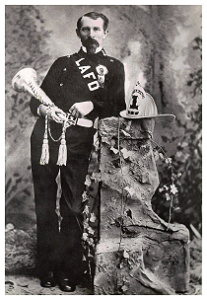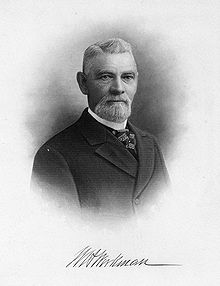
We begin in January 1887 when, according to the Los Angeles Times,
There has been great complaint about the abominable fashion in which the sidewalks—especially at street corners—are blocked up by loafers and by thoughtless citizens; and the police have been ordered to enforce the ordinances and abate this nuisance.1
Even then, evidently, maybe especially then, an order to “enforce the ordinances” had a subtext. Ensuing events show that Officer Little didn’t understand these unspoken aspects:
Little has been carrying out these orders diligently, and has cleared out more than one animate obstruction to travel. Finally he ran across a crowd which was blocking the sidewalk at the corner of Main and First and ordered them to move on. He didn’t know who they were, but supposed they were amenable to the law.2 One of them, who was Mr. Kuhrts,3 said: “This sidewalk belongs to me. I won’t move on.” Little took him by the councilmanic arm and moved him on. Another of the party bristled up pugnaciously, and Little shoved him aside with the easy grace with which he might evict a fly from his nose.1
Well, the councilmanic dignity was offended, and, as the Times reported, Kuhrts complained to the Police Commissioners. At that point, the opinion of the anonymous Times reporter was clearly tilted towards the cop, as can be seen from his summary:

Probably the Times reporter thought that, as St. Peter taught us of God, the law was no respecter of persons. Silly Times reporter! Here’s what happened the next day at the hearing:
Chairman W.H. Workman moved, “That as Officer Little had exceeded his authority as an officer and acted in a very arbitrary manner in the affair at the northwest corner of First and Main streets on Sunday, he be suspended for two weeks, without pay, as a penalty for his offensive action and language.” The motion was lost for want of a second.
L.N. Breed offered as a substitute, “After hearing the evidence in this case, the Police Commissioners are of the opinion that Officer Little exceeded his authority and used improper language in the discharge of his duty: we, therefore, recommend that he be reprimanded in the presence of the Commissioners.” Seconded by Chief J.K. Skinner. Motion carried. Officer Little was then called in and reprimanded by Chairman W.H. Workman. [His offense was making Councilman J. Kuhrts “move on” when the latter was obstructing the sidewalk.]4
Read in today’s terms, “loafers” are the homeless, and the ordinances are to be enforced against them and them only. The rich and powerful, who control the enforcement apparatus, make good and goddamned sure that these laws are not used against white people, people with houses, and so on. We’ve written about this in detail at least here and here. The only difference now is that the monied and powerful have their shit together enough so that cops don’t make the same mistake Officer Little made. Also probably councilmembers aren’t to be found on the sidewalk without armed entourages. plus ça change, plus c’est la même chose.5
- MOVE ON. A Policeman Who Makes Even Councilmen Mind the Rules. Los Angeles Times. January 11, 1887. Page 1.
- This was your first mistake, Officer Little. They’re not amenable to the law as it applies to them. They never have been and evidently they never will be. The law is for the “loafers and … thoughtless citizens,” never for their masters.
- At that time a sitting member of the Los Angeles City Council.
- POLICE COMMISSIONERS. Officer Little Reprimanded—Uniform for Police—Appointments Los Angeles Times. January 12, 1887. Page 1. Note that the square brackets and the verbiage therein enclosed are in the original document.
- H/T Jean-Baptiste Alphonse Karr, verified person being quoted here, n’est-ce pas?
Images of Jacob Kuhrts and William H. Workman are in the public domain due to age and are available via Wikimedia here and here respectively. Images of LA Times articles are likewise public domain.
